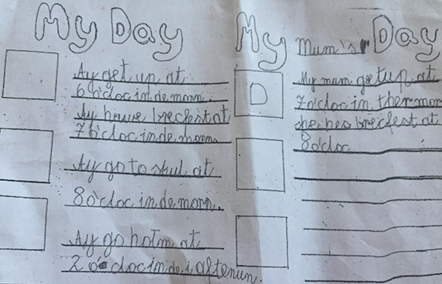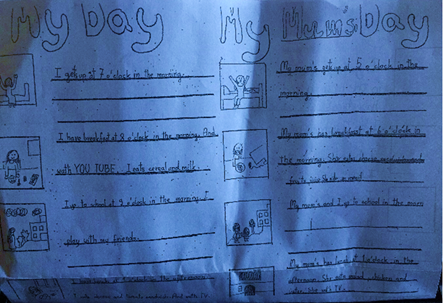Writing with Young Learners
By Amy Gowers
Setting up writing activities can be tricky; we know this from personal experience and experiences shared by other teachers. Knowing how to make young learners (YLs) aware of our expectations without putting pressure on them and ensuring they have had enough exposure to the required language, can mean the difference between a multi-paragraph piece or a few unfocused sentences.
This article explores how to encourage YLs to produce longer and more substantial writing. It is adapted from my 2019 IH Torun Teacher Training Day workshop. The lesson plan can be found on my blog AmyEnglishLanguage.home.blog.
Expectations & differentiation
Knowing your expectations, for the whole class and for individual students, before you enter the classroom and before you even fully plan the lesson can make a huge difference. A trend I have noticed with newer teachers, who are perhaps afraid of pushing the students too far and upsetting them, is that their expectations of the students and what they are prepared to accept is too low. YLs are flexible learners and will meet any expectation you give them as long as they are aware of what those expectations are. My high expectations set my students up for success and not failure, as you can see from their examples below. Always pushing students means that each time they write, they’ll produce more and more.
Preparing for writing
The aim of this lesson is for students to make a poster describing their day and their parents’ day, by using daily routine phrases (have breakfast, go to school, etc.) and daily time phrases (in the morning, at night, etc.). I included a number of different stages, each one focusing on something different. This variety is important because it gives weaker students valuable exposure, and stronger students a license to experiment with their language. Asking students to draw during writing preparation activities piques their interest in the topic and allows them to prepare for the final task without having to do more writing.
As this lesson was at the end of a unit, none of the language or vocabulary was new. The focus was on revising and filling any gaps in their knowledge. Using the warmer to review is a quick and easy way to revise old language.
Writing stage
While writing, the teacher should repeatedly check in with the students, monitoring for engagement, encouragement purposes and behaviour control. It’s all too common for students to be engaged and interested during group activities but become overwhelmed when faced with an empty piece of paper. A lot of the problems that usually surface during this stage can be avoided quite simply by efficient and active monitoring.
Post writing
After writing, students mingled and showed each other their work. At this age relating things to their personal life is extremely important and having written about their parent, friend or family member they are even more invested in their work. YLs love showing off what they’ve created to their classmates and being able to tell their classmate about their home life makes an activity even more worthwhile. Linguistically, the further exposure to the spoken language is also a positive.
Marking
This was an assessed piece of writing, so the marking scheme was quite strict. The students were marked out of 5 for content and 5 for accuracy. To receive 5 for content they needed to have included all of the language and/or topics that were discussed earlier on in the lesson. It is unfair to expect students at this age and at this level to produce grammatically perfect pieces of writing; therefore, to receive a five the students needed to have shown an understanding of the grammar through repeated accurate use. I allow for a few errors as long as I can see that these are merely slips and not gaps in understanding. We also work hard on spelling and phonics in my class, so I consider spelling when looking at accuracy. To see what grade I awarded the two examples below and an explanation as to why they received those grade go to my blog: AmyEnglishLanguage.home.blog
Example 1:

Example 2:

Anticipated problems and solutions
During the IH Torun Training workshop, we discussed what problems individual teachers would have when trying to adapt this plan for their classes. Here are some of those issues and my solutions.
1. Students might quickly write some sentences down and then shout FINISHED without paying proper attention to their work.
Solution
Monitoring is key here, monitoring for content as well as accuracy will keep the students on track. Having the list of topics on the board helps the students to remember what they need to write about and can keep them on task. Below is the exact conversation I had with many of my students:
Ss. ‘Finished.’
T. ‘Have you got time?’
Ss. ‘Yes,’ points to time.
T. ‘Okay what’s next on the list?’
Ss. ‘Food.’
T. ‘Have you got food?’
Ss. ‘No.’
T. ‘Okay then, off you go.’
Drawing the students’ attention to the list a couple of times will eventually lead to them to check it themselves, thus leading them to have more autonomy over their work in the future.
2. Some students may refuse to do any writing.
Solution
First of all, find out why they don’t want to do any writing. Usually if a student is refusing to complete a piece of work there’s a particular reason why. Perhaps they aren’t confident at writing or perhaps they view writing as a boring and a chore, they may even they feel overwhelmed with the amount of writing they are expected to do. Once you know why the student is reluctant, it’s easier to persuade them to do it.
3. One of my students gets upset when asked to do writing because she is younger than the other students and she can’t write as quickly or as much as the others do.
Solution
It’s unfair to have the same expectation for every student in the class, as even children who are the same age and around the same level will be better or worse at different things. Once you set students an activity and you have time to give a little extra attention to certain students while monitoring, it’s fine to give each student mini targets, like rungs on a ladder, which will help them complete the activity. This could be asking the student a question, e.g. ‘what is the first thing you do in the morning?’ and when the student answers, encourage them to write this as their first sentence. Another example could be referring them to the boarded topic list and asking them to write a sentence for one topic. When you circle back round to them, after spending time with the other students, ask them to write a sentence about the second topic and so on and so forth.
4. Some students aren’t as creative as others and find it difficult coming up with ideas of what to write about.
Solution
Having a dedicated idea generating section before the students are asked to do a piece of writing is vital. Not only does it give them time to think of ideas and discuss these ideas with their classmates, but it also allows them time to digest all the input they’ve had in the run up to the writing.
Conclusion
Any teacher who wants to improve the writing of their YLs and increase the amount they produce, must follow this advice:
- Exposure, exposure, exposure. Giving the students sufficient exposure to example pieces of writing lets them know what is expected of them.
- Ideas generation. Giving the students time to think about what they want to write before they come to writing helps speed up the process as they already know what they want to write. It also avoids the typical “Teacher. I don’t know” comments.
- Monitoring and speaking to individual students makes them feel comfortable. Reading what the students have written and asking them questions about it (rather than pointing out their mistakes) makes them responsible for their own work, and usually they’re able to notice and correct their mistakes themselves. Errors at this level are easier to hear then they are to read so simply reading the line back to them helps them see.
 |
Author's Bio: Amy Gowers has worked as a teacher in Tokyo, the UK and currently in Poland. She has a keen interest in YLs and has worked with children and teens for over nine years. If anyone has any questions or would like to discuss anything read in this article with her, they can contact her on through her Facebook page Amy EFL, her Instagram account Amy.EnglishLanguage2019 or her blog AmyEnglishLanguage.home.blog |